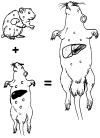Clinical xenotransplantation
- PMID: 21151801
- PMCID: PMC3000172
- DOI: 10.1111/j.1399-3089.1994.tb00044.x
Clinical xenotransplantation
Abstract
Two baboon liver xenografts transplanted to patients with B virus hepatitis supported life for 70 and 26 days but did not function optimally despite minimum or no histopathologic findings of overt humoral or cellular rejection in serial biopsies. However, there was evidence of complement activation in both cases, which in retrospect was thought to explain the unsatisfactory outcome. Strategies to deal with this problem are discussed.
Figures



Similar articles
-
The biological basis of and strategies for clinical xenotransplantation.Immunol Rev. 1994 Oct;141:213-44. doi: 10.1111/j.1600-065x.1994.tb00879.x. Immunol Rev. 1994. PMID: 7868154 Free PMC article. Review.
-
Heteroagglutinins and their significance in baboon hepatic xenotransplantation.Transplantation. 1995 Jul 27;60(2):127-31. doi: 10.1097/00007890-199507000-00003. Transplantation. 1995. PMID: 7624953 Free PMC article.
-
The study of mitoxantrone as a potential immunosuppressor in transgenic pig renal xenotransplantation in baboons: comparison with cyclophosphamide.Xenotransplantation. 2004 Mar;11(2):112-22. doi: 10.1111/j.1399-3089.2004.00040.x. Xenotransplantation. 2004. PMID: 14962273
-
Life-supporting human complement regulator decay accelerating factor transgenic pig liver xenograft maintains the metabolic function and coagulation in the nonhuman primate for up to 8 days.Transplantation. 2000 Oct 15;70(7):989-98. doi: 10.1097/00007890-200010150-00001. Transplantation. 2000. PMID: 11045632
-
Clinical trials and projected future of liver xenotransplantation.World J Surg. 1997 Nov-Dec;21(9):956-61. doi: 10.1007/s002689900333. World J Surg. 1997. PMID: 9361511 Free PMC article. Review.
Cited by
-
The resurgent landscape of xenotransplantation of pig organs in nonhuman primates.Sci China Life Sci. 2021 May;64(5):697-708. doi: 10.1007/s11427-019-1806-2. Epub 2020 Sep 21. Sci China Life Sci. 2021. PMID: 32975720 Review.
-
Occurrence of specific humoral non-responsiveness to swine antigens following administration of GalT-KO bone marrow to baboons.Xenotransplantation. 2010 Jul-Aug;17(4):300-12. doi: 10.1111/j.1399-3089.2010.00600.x. Xenotransplantation. 2010. PMID: 20723202 Free PMC article.
-
The biological basis of and strategies for clinical xenotransplantation.Immunol Rev. 1994 Oct;141:213-44. doi: 10.1111/j.1600-065x.1994.tb00879.x. Immunol Rev. 1994. PMID: 7868154 Free PMC article. Review.
References
-
- Shiraishi M, Csete ME, Yasunaga C, et al. Regeneration-induced accelerated rejection reduced-size liver grafts. Transplantation. 1994;57:336. - PubMed
-
- Jonjic S, Radosevic-Stasic B, Cuk M, et al. Class II antigen induction in the regenerating liver of rats after partial hepatectomy. Transplantation. 1987;44:165. - PubMed
Grants and funding
LinkOut - more resources
Full Text Sources
